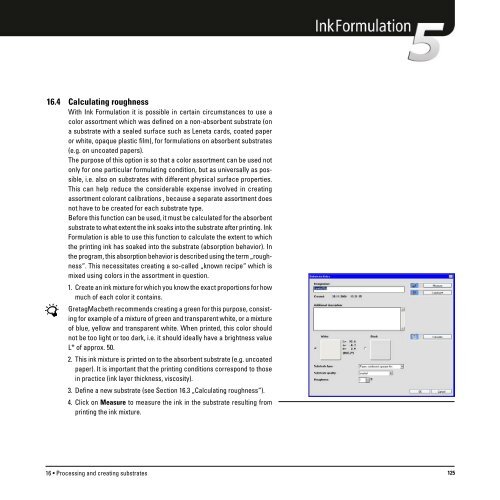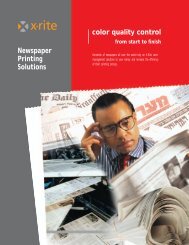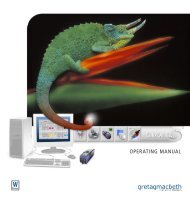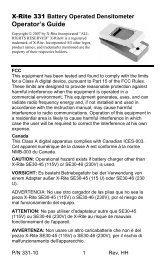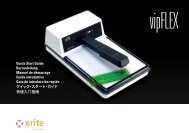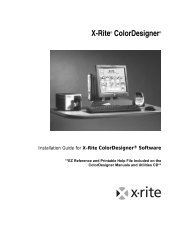Operating Manual
Operating Manual
Operating Manual
Create successful ePaper yourself
Turn your PDF publications into a flip-book with our unique Google optimized e-Paper software.
16.4 Calculating roughness<br />
With Ink Formulation it is possible in certain circumstances to use a<br />
color assortment which was defined on a non-absorbent substrate (on<br />
a substrate with a sealed surface such as Leneta cards, coated paper<br />
or white, opaque plastic film), for formulations on absorbent substrates<br />
(e.g. on uncoated papers).<br />
The purpose of this option is so that a color assortment can be used not<br />
only for one particular formulating condition, but as universally as possible,<br />
i.e. also on substrates with different physical surface properties.<br />
This can help reduce the considerable expense involved in creating<br />
assortment colorant calibrations , because a separate assortment does<br />
not have to be created for each substrate type.<br />
Before this function can be used, it must be calculated for the absorbent<br />
substrate to what extent the ink soaks into the substrate after printing. Ink<br />
Formulation is able to use this function to calculate the extent to which<br />
the printing ink has soaked into the substrate (absorption behavior). In<br />
the program, this absorption behavior is described using the term „roughness“.<br />
This necessitates creating a so-called „known recipe“ which is<br />
mixed using colors in the assortment in question.<br />
1. Create an ink mixture for which you know the exact proportions for how<br />
much of each color it contains.<br />
GretagMacbeth recommends creating a green for this purpose, consisting<br />
for example of a mixture of green and transparent white, or a mixture<br />
of blue, yellow and transparent white. When printed, this color should<br />
not be too light or too dark, i.e. it should ideally have a brightness value<br />
L* of approx. 50.<br />
2. This ink mixture is printed on to the absorbent substrate (e.g. uncoated<br />
paper). It is important that the printing conditions correspond to those<br />
in practice (ink layer thickness, viscosity).<br />
3. Define a new substrate (see Section 16.3 „Calculating roughness“).<br />
4. Click on Measure to measure the ink in the substrate resulting from<br />
printing the ink mixture.<br />
16 • Processing and creating substrates 125


